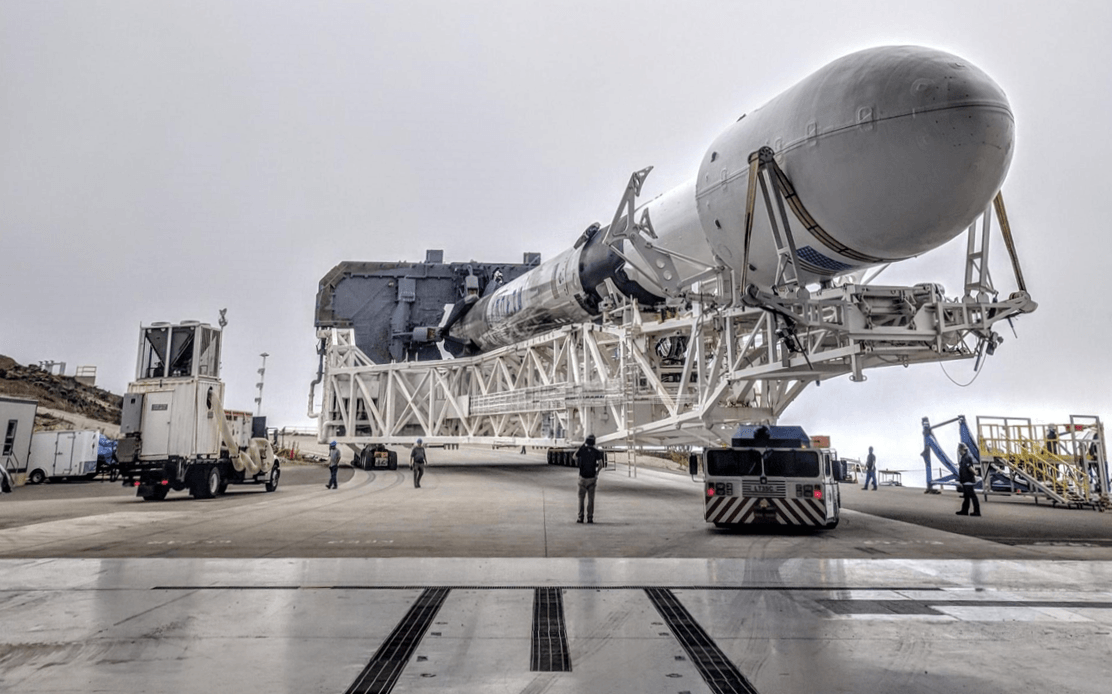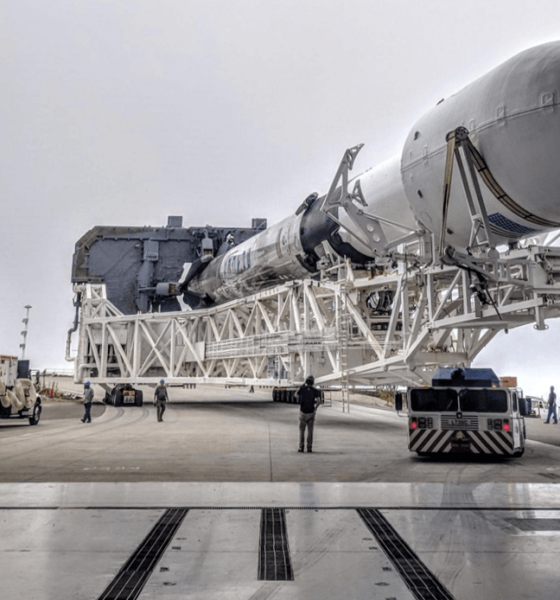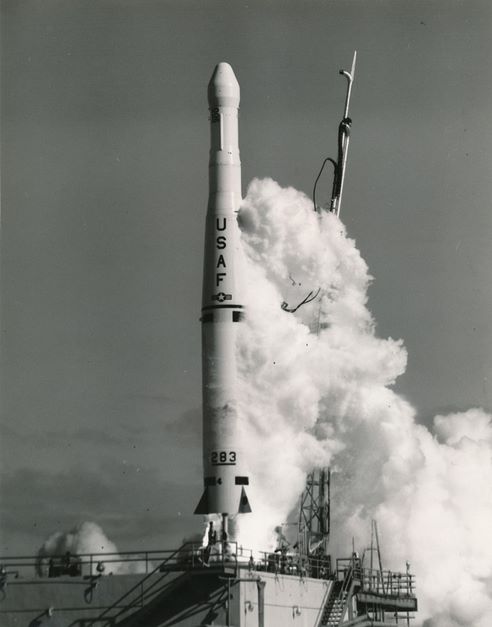

News
SpaceX to shift Falcon 9’s next West Coast launch to Florida, the first of its kind in decades
According to NASASpaceflight spaceflight reporter Michael Baylor and an Argentinian government website, SpaceX appears to have decided to move its next West Coast launch from California to Florida, signifying the first East Coast polar launch in half a century could be just four months away.
Initially expected to launch out of SpaceX’s Vandenberg Air Force Base (VAFB) SLC-4E pad on a Falcon 9 rocket, the Argentinian space agency’s (CONAE) SAOCOM-1B Earth observation satellite was scheduled to lift off no earlier than February 2020. That launch window remains the same but Florida’s Cape Canaveral Air Force Station (CCAFS) has somehow arranged approval to reopen the United States’ Eastern polar launch corridor. The story behind the corridor’s closure is a bizarre one.
Having earned itself a bit of notoriety and fame over the years, the story of the closure of the Eastern polar launch corridor is simple on the outset. In November 1960, a Thor Able-Star rocket lifted off from Cape Canaveral for what was hoped to be a routine military launch. This particular mission carried GRAB II, a covert signals intelligence spacecraft designed to spy on radio communications around the globe.
Long story short: that Thor rocket suffered a failure that caused the booster to prematurely shut down and divert from its planned trajectory, forcing the range safety officer to manually trigger the rocket’s self-destruct mechanisms. Broken apart by explosives, one unlucky cow – standing in a Cuban field some 400 miles (650 km) downrange – was struck by rocket debris, killing the farm animal. Indeed, this might initially seem like an absurd reason to entirely end the practice of polar orbital launches from Cape Canaveral, but Cold War tensions were extremely high and President Fidel Castro leaped on the opportunity to hound the US.

An article published in a 2008 issue of the US Naval History Magazine covers this minor debacle in greater detail, shedding some much-needed light on why things played out how they did.
“In what somewhat inaccurately became known as “the herd shot around the world,” some of the falling rocket debris apparently splattered on a Cuban farm and killed a cow. “This is a Yankee provocation,” accused Revolucion, an official Cuban publication, insisting that the rocket was deliberately exploded over the country. Government radio stations cited the incident as further proof that the United States was trying to destroy the regime of Cuban President Fidel Castro. One cow was even paraded in front of the U.S. Embassy in Havana wearing a placard reading “Eisenhower, you murdered one of my sisters.”
Castro filed a complaint at the United Nations, and Washington sheepishly conceded the possibility that “fragments from the rocket booster” could have landed in Cuba. CIA Director George Tenet later quipped somewhat tastelessly that it was “the first, and last, time that a satellite had been used in the production of ground beef.” Further launches overflying Cuba were postponed, and improvements were made to the Cape Canaveral range-safety system. In any case, it was a dejected NRL group that returned to Washington.”
Naval History Magazine – April 2008
That overflight postponement was never withdrawn and VAFB – located on the coast of California – has supported all US polar launch** activity since late-1960. Public word of the possible reopening of the Eastern polar launch corridor came 57 years later when Wayne Monteith, commander of the 45th Space Wing, revealed that he had tasked analysts to determine whether the corridor could be reopened in light of wildfire troubles that closed VAFB’s Western Range in 2016. They concluded that there were no obvious technical showstoppers.
**There is a report that a Thor Delta C rocket performed two sun synchronous orbit (SSO; ‘nearly polar’) launches in the mid-1960s, overflying Cuba in the process, but it’s unclear if the trajectory used was the same as those used before Thor’s 1960 GRAB II failure.
A reporter who was present at the press conference said that SpaceX’s SAOCOM 1B launch hadn’t officially been put on on the Eastern Range’s planning schedule, indicating that some work remains before it can truly be said that the Eastern polar launch corridor has been reopened. Nevertheless, Douglas Schiess, the current commander of the 45th Space Wing, was obviously confident that those final steps are more technicalities than potential showstoppers and that 21st-century Eastern polar launches are now a question of “when”, not “if”.
In Monteith’s 2017 statement, it was stated that there is one major condition on the reopening: all launch vehicles intending to fly it must feature autonomous flight termination systems (AFTS). This is due to the risk that the rocket’s plume might prevent the reliable reception of radio telemetry at Florida-based tracking stations. SpaceX is currently the only launch provider in the world to have implemented AFTS and is thus the only provider currently capable of launching polar missions from Florida.

Time will tell just how extensive Florida’s polar launch capabilities are and how dramatically the new capability will impact Vandenberg’s commercial launch ecosystem. Speaking in 2017, Monteith was fairly blunt in his assessment that California was not only tepid on the subject of expanding VAFB’s commercial launch manifest, but was actively hostile at points. His point: if Vandenberg isn’t going to put effort into stimulating a commercial polar launch ecosystem, Cape Canaveral might as well try.
VAFB is currently in the throes of a four-month launch lull previously expected to last until SpaceX’s Feb. 2020 SAOCOM 1B launch. Depending on how things play out for startup Firefly Aerospace and how readily CCAFS can take to its new polar launch role, Vandenberg’s lull could easily stretch into the second half of 2020, perhaps more than a year between launches.
Check out Teslarati’s Marketplace! We offer Tesla accessories, including for the Tesla Cybertruck and Tesla Model 3.

Elon Musk
Elon Musk’s X will start using a Tesla-like software update strategy
The initiative seems designed to accelerate updates to the social media platform, while maintaining maximum transparency.

Elon Musk’s social media platform X will adopt a Tesla-esque approach to software updates for its algorithm.
The initiative seems designed to accelerate updates to the social media platform, while maintaining maximum transparency.
X’s updates to its updates
As per Musk in a post on X, the social media company will be making a new algorithm to determine what organic and advertising posts are recommended to users. These updates would then be repeated every four weeks.
“We will make the new 𝕏 algorithm, including all code used to determine what organic and advertising posts are recommended to users, open source in 7 days. This will be repeated every 4 weeks, with comprehensive developer notes, to help you understand what changed,” Musk wrote in his post.
The initiative somewhat mirrors Tesla’s over-the-air update model, where vehicle software is regularly refined and pushed to users with detailed release notes. This should allow users to better understand the details of X’s every update and foster a healthy feedback loop for the social media platform.
xAI and X
X, formerly Twitter, has been acquired by Elon Musk’s artificial intelligence startup, xAI last year. Since then, xAI has seen a rapid rise in valuation. Following the company’s the company’s upsized $20 billion Series E funding round, estimates now suggest that xAI is worth tens about $230 to $235 billion. That’s several times larger than Tesla when Elon Musk received his controversial 2018 CEO Performance Award.
As per xAI, the Series E funding round attracted a diverse group of investors, including Valor Equity Partners, Stepstone Group, Fidelity Management & Research Company, Qatar Investment Authority, MGX, and Baron Capital Group, among others. Strategic partners NVIDIA and Cisco Investments also continued support for building the world’s largest GPU clusters.
News
Tesla FSD Supervised wins MotorTrend’s Best Driver Assistance Award
The decision marks a notable reversal for the publication from prior years, with judges citing major real-world improvements that pushed Tesla’s latest FSD software ahead of every competing ADAS system.

Tesla’s Full Self-Driving (Supervised) system has been named the best driver-assistance technology on the market, earning top honors at the 2026 MotorTrend Best Tech Awards.
The decision marks a notable reversal for the publication from prior years, with judges citing major real-world improvements that pushed Tesla’s latest FSD software ahead of every competing ADAS system. And it wasn’t even close.
MotorTrend reverses course
MotorTrend awarded Tesla FSD (Supervised) its 2026 Best Tech Driver Assistance title after extensive testing of the latest v14 software. The publication acknowledged that it had previously criticized earlier versions of FSD for erratic behavior and near-miss incidents, ultimately favoring rivals such as GM’s Super Cruise in earlier evaluations.
According to MotorTrend, the newest iteration of FSD resolved many of those shortcomings. Testers said v14 showed far smoother behavior in complex urban scenarios, including unprotected left turns, traffic circles, emergency vehicles, and dense city streets. While the system still requires constant driver supervision, judges concluded that no other advanced driver-assistance system currently matches its breadth of capability.
Unlike rival systems that rely on combinations of cameras, radar, lidar, and mapped highways, Tesla’s FSD operates using a camera-only approach and is capable of driving on city streets, rural roads, and freeways. MotorTrend stated that pure utility, the ability to handle nearly all road types, ultimately separated FSD from competitors like Ford BlueCruise, GM Super Cruise, and BMW’s Highway Assistant.
High cost and high capability
MotorTrend also addressed FSD’s pricing, which remains significantly higher than rival systems. Tesla currently charges $8,000 for a one-time purchase or $99 per month for a subscription, compared with far lower upfront and subscription costs from other automakers. The publication noted that the premium is justified given FSD’s unmatched scope and continuous software evolution.
Safety remained a central focus of the evaluation. While testers reported collision-free operation over thousands of miles, they noted ongoing concerns around FSD’s configurable driving modes, including options that allow aggressive driving and speeds beyond posted limits. MotorTrend emphasized that, like all Level 2 systems, FSD still depends on a fully attentive human driver at all times.
Despite those caveats, the publication concluded that Tesla’s rapid software progress fundamentally reshaped the competitive landscape. For drivers seeking the most capable hands-on driver-assistance system available today, MotorTrend concluded Tesla FSD (Supervised) now stands alone at the top.
News
Elon Musk’s Grokipedia surges to 5.6M articles, almost 79% of English Wikipedia
The explosive growth marks a major milestone for the AI-powered online encyclopedia, which was launched by Elon Musk’s xAI just months ago.

Elon Musk’s Grokipedia has grown to an impressive 5,615,201 articles as of today, closing in on 79% of the English Wikipedia’s current total of 7,119,376 articles.
The explosive growth marks a major milestone for the AI-powered online encyclopedia, which was launched by Elon Musk’s xAI just months ago. Needless to say, it would only be a matter of time before Grokipedia exceeds English Wikipedia in sheer volume.
Grokipedia’s rapid growth
xAI’s vision for Grokipedia emphasizes neutrality, while Grok’s reasoning capabilities allow for fast drafting and fact-checking. When Elon Musk announced the initiative in late September 2025, he noted that Grokipedia would be an improvement to Wikipedia because it would be designed to avoid bias.
At the time, Musk noted that Grokipedia “is a necessary step towards the xAI goal of understanding the Universe.”
Grokipedia was launched in late October, and while xAI was careful to list it only as Version 0.1 at the time, the online encyclopedia immediately earned praise. Wikipedia co-founder Larry Sanger highlighted the project’s innovative approach, noting how it leverages AI to fill knowledge gaps and enable rapid updates. Netizens also observed how Grokipedia tends to present articles in a more objective manner compared to Wikipedia, which is edited by humans.
Elon Musk’s ambitious plans
With 5,615,201 total articles, Grokipedia has now grown to almost 79% of English Wikipedia’s article base. This is incredibly quick, though Grokipedia remains text-only for now. xAI, for its part, has now updated the online encyclopedia’s iteration to v0.2.
Elon Musk has shared bold ideas for Grokipedia, including sending a record of the entire knowledge base to space as part of xAI’s mission to preserve and expand human understanding. At some point, Musk stated that Grokipedia will be renamed to Encyclopedia Galactica, and it will be sent to the cosmos.
“When Grokipedia is good enough (long way to go), we will change the name to Encyclopedia Galactica. It will be an open source distillation of all knowledge, including audio, images and video. Join xAI to help build the sci-fi version of the Library of Alexandria!” Musk wrote, adding in a later post that “Copies will be etched in stone and sent to the Moon, Mars and beyond. This time, it will not be lost.”








